Over the years I have used many LED tail lights since I do more than my share of night riding on brevets or double-century rides. Below is quick review of many of the popular brands.
I have seen many lights that are have less than 1/2-watt output. Typically, these lights have three or more weak LEDs and although the multiple LEDs may look cute in the store, they simply don’t have the punch or visibility to motorists. I remember on a 400k ride, a friend of mine had one those off-brand 5 LED tail lights. It looked very dim. I mentioned it to him and he changed out the batteries, but to no avail. I asked him what brand it was. He wasn’t sure, but that he got it on eBay for $3 or $4. Later that season he got bumped by the mirror of a passing motorist while commuting home on his bicycle! Fortunately he was not badly injured — in fact he stayed upright and was not knocked over. Shortly after that, myself and another friend each bought him a 1/2-watt tail light.
Your safety is not worth cutting corners when it comes to lighting!
In 2013 I purchased the 2-watt Cygolite Hotshot because it has a USB rechargeable battery, which I was wanted to use on my daily training rides (I put a piece of gaffer tape on the top of it to act as an awning so it shows, even during the day). The Hotshot mounting system is a really bad design. Despite tightening to the maximum, it still drooped as shown in the photo, pointing down to the ground. So I taped it on the top, holding it parallel to the ground and then on a 50-mile ride, it just fell off (unbeknownst to me!). This light always had too many adjustable settings and was confusing. On a 600K, one of my fellow riders with a Cygolite Hotshot tail light mount also failed (while crossing some rumble strips near Zion National Park in Utah), leaving his light somewhere along the side of the road. Although I like their now-discontinued Turbo 740Xtra headlights a lot, I cannot recommend the original Cygolite Hotshot tail light.
The PrincetonTec Swerve has a great 1/2 watt lighting random flash pattern (I don’t recommend anything less than 1/2 watt). It does droop a little too (but not near as much as the Cygloite Hotshot). By using an extra 0-ring or a smaller o-ring that supplied, I have been able to stabilize this light. The switch is large and very easy to use. The claimed burn time is 24 hours for constant and 70 hours in flash mode with two AAA batteries.
The Planet Bike tail lights have reported leakage problems in heavy rain, so many cyclists mount them upside down. I have never used them and have found the lighting pattern on the Swerve and Tail Blazer to be superior anyway.
I have tested the 1/2 watt Sigma Tail Blazer. It doesn’t droop and the mount appears secure the clip on the back of the light fails very easily when attached to a bicycle frame. It has two 1/2 watt LEDs. Regretfully (June 2014), on a recent 600K ride, while crossing over some rumble strips, the clip mount on the back of the light sheared off and the light hit the deck. It didn’t shatter, but was useless as I couldn’t remount it to my seat stay, or even attach it to a bag. Although Sigma quickly sent me a new unit, the design is unchanged. The switch is flush “under the shell” button that is hard to use with gloved hands. Even with no gloves, I have had to use my fingernails to jab it “just right” to turn this on or off. At least it won’t turn on accidentally while in transport. I cannot recommend this discontinued model except when attached to an ankle band.
This summer (2013) I purchased the new Sigma Stereo. It is a USB rechargeable tail light. I used it, simultaneously with a Tail Blazer this summer while on a 3-day 1200K. The Tail Blazer was much, much brighter, according to other cyclists that rode behind me. The Stereo wastes it wattage by illuminating a cute ring or border around the perimeter of the light, which does nothing to attract motorists at a distance. I cannot recommend this tail light either.
November 2013 Update: I picked up a Lezyne Micro Drive. It is designed ONLY to fit on a seatpost. I use this light for daylight use. It is rated at 100 lumens in flash mode. It is USB rechargeable and is reasonably bright for daylight use. (They have now have a newer model called the Micro Drive 180 that is brighter). I also made a small awning out of gaffer tape, so the light is more visible during the day. I now use it regularly on training rides as it only lasts 3–4 hours. The build quality (CNC machining) on all Lezyne products is incredible. For a front daylight running light, I use the similarly designed Lezyne Hecto Drive, which is rated at 70 lumens in flash mode.
During the summer of 2014 one of my distributors starting carrying Portland Design Works (PDW) lights, so I decided to give some of them a try. I tried the USB-rechargeable Aether Demon (1/2 watt) and the RADBOT 1000. The Aether Demon is not quite as bright as the Lezyne Micro Driver Rear, but I can get about eight hours in blink mode from it. In September of 2104 I did a 420-mile relay race solo style, with about 500 others (there were only 9 solo riders). My support crew that was following me reported that the combination of the 1-watt PDW Radbot 1000 on my seat stay and a 1/2-watt Sigma Tail Light mounted to my ankle, was “hands down” brighter than any other cyclist they saw that night…and they saw hundreds of them. The only thing I do not like about the RADBOT 1000 is that it requires a flat Phillips screwdriver to open it when replacing the AAA batteries — but then, one needn’t worry about the front part of the light separating from the base as is the case with some other brands (many cyclists wrap rubber bands around their lights for this purpose “just to be sure,” but that is NOT necessary with this light). Also, there is no rubber gasket seal like the PrincetonTec Swerve, so I am left to wonder if it will leak in heavy rains. I asked the rep at PDW about rain and the response was “We do certainly see some lights come back that have had water leaks but it’s always hard to tell if it is an issue with the light or weather the rubber gasket got popped out a little when batteries were changed. Living in the Pacific Northwest we certainly put all our lights to the test on a regular basis as far as rain goes.” As a side, the 1/2-watt PDW Danger Zone doesn’t require a screwdriver to open. All three of these PDW lights use the same mount, which has a little slop where the clip on the light mounts to the mount, thus hopefully providing a some give, yielding a “rumble strip, fail safe” attachment.
Many of the reviews (i.e. as seen on REI.com) do not give the Niterider Sentinel 150 glowing reports. The mount has issues and fails easily. It also doesn’t have a memory so when one shuts it off, it doesn’t restart on the same mode.
Fall 2017 Update: PDW has introduced the Daybot USB Tail Light. It puts out up to 100 lumens for daylight visibility or it can be switched it to 20 lumens for night use. (The upper LED puts out 100 lumens, whereas the lower LED puts out about 20). It is USB chargeable and claims to provide 20 hours of use in daylight pulse mode (I found it only provides 10 hours when used continually). It uses a different mount than my other PDW lights, so I can’t move it around on my other bikes that have the old-style mount already on them. This light on the night mode is great with it’s quick flashing light, but the daytime mode has a very slow “pulse” cycle. It cycles between the upper brighter LED and lower dimmer LED; the day mode doesn’t have a similar “quick blink” mode. It cycles onto the upper bright light 20 times in 34 seconds. The night quick cycle mode is about 2.5 times faster. I am fearful that a motorist might glance over while the LED is dark and not see me. Perhaps this was done to prolong battery and also to not irritate other commuting cyclists.
In 2017 I purchased a pair of the Seattle Sports GloStraps and attached them to my calf. On a rural 400km brevet (with little ambient city lights) I then asked some friends that were 1/8 to 1/4 mile behind me to evaulate. At distance, it was rather ineffective compared to my 1/2-watt blinky light, which was mounted on my seat stay. There are other brands with similar offerings and my feeling is that they may be useful for commuting or when in traffic as it gives motorists that are in close proximity 180-degree visibility, but for general lighting purposes I would not bother. Instead I have mounted a secondary blinky to my reflective ankle bands.
December 2017 Update: I got my hands on the Cygolite Hotshot 150 USB tail light. The tempo of the daylight blinking light setting (they call it DayLighting™) is adjustable (which was my gripe with the runner up light, the PDW Daybot USB) so it can set to a very quick pace at full power with 150 lumens. The slowest setting provides some 38 hours of light (verified). It also has solid modes and for my solo night riding, the Triple Flash mode. The mounts on previous Cygolite tail lights were cheaply designed and broke off when I hit a series of rumble strips. This mount has been redesigned and so so far, it is holding up.
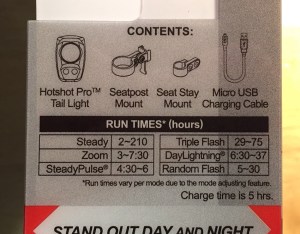
There are four factors when choosing a tail light:
- Sturdiness of the mount when used on a seat stay, which is my preferred location. So far, many that I have tried either break off (Sigma & pre-2016 Cygolite) or droop (Princeton Tec with OEM o-rings). The PDW RADBOT 1000 is the best I have tested thus far. On my Trek Domane road bike, the seat stays are very skinny and consequently the clamp-on style lights sometimes require stuffing some scraps of closed cell foam inside so it will clamp down tightly. The Princeton Tec shines in that regard as it uses a stretchy o-ring instead.
- If you are doing long “straight through the night” 600K brevets or 24-hour style rides, be careful with the rechargeable models as some only last 5-7 hours (update: many 2017 models have improved run time and now go for 15 to 20 hours blinking on a charge). On the other hand, most AAA-battery models last 20–30 hours.
- Brightness. Lights with multiple (i.e. 3-6) LEDs are usually dimmer than one bright light. Get one that is at least 1/2-watt (1 watt preferred) or 50 lumen (150 lumens for day use).
- It is weatherproof. Will it leak in heavy rains?

Summary…
For all daylight rides, I consistently use the Cygolite Hotshot 150 USB as my “daylight running light.” I can get 12 to 15 hours in a moderately slow flash mode.
For night riding, I keep the Hotshot 150 on my bike but turn it off and use either the 1-watt PDW Radbot 1000 or PrincetonTec Swerve mounted to a seat stay. This is supplemented by a Sigma Tail Blazer, mounted to a custom reflective strap on my ankle. I prefer tail lights that attach to the seat stay, as I frequently have a seat bag that covers up the seatpost and attaching a light to the bag rarely yields a light that is facing the correct angle in the back.
For a front daylight running light, consider something with at least 200 lumens and with a single LED, not a light with multiple dimmer LEDs. I have been using the Lezyne Hecto Drive, which only puts out 70 lumens in flash mode.


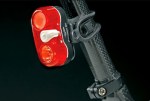
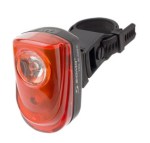
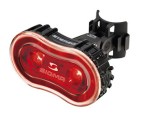



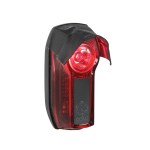


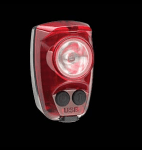
I don’t have any issues with the waterproof capability of the Planet Bike SuperFlash. I commute and ride brevets in Portland, Oregon, so I think it gets a fair workout in the rain. It does rest in a garage at nigh and inside a heated building at work, so it gets dried out after each ride. Today, on a shop ride, I noticed that 4 of 5 of us use models from Planet Bike. I think the other was a Blackburn. It’s not just me.
I agree that 1/2 W is a good minimum. I’d consider the SuperFlash Turbo if I needed to replace one of mine.
I do like the idea of USB charge. I’m disappointing to hear the mounting system did not work for you.
LikeLike
Good review that I saw linked from Google Rando group. I’d suggest trying the NiteRider Solas. It’s similar to the Cygolite Hotshot (2 watt, USB rechargeable) but has a simple thumbscrew to tighten to either the seat post or the seatstay mount. There’s also a clip. The light is more diffused than the Hotshot, its runtime is shorter and its is a bit more expensive (about $38).
LikeLike
It’s a shame about the Cygolite mounting system. I clip mine to my seatbag so it hasn’t been an issue. I bought mine to replace a Superflash Turbo, which kept coming apart and falling off. The Cygolite is screwed together and stays put where it’s clipped on. I REALLY like the rechargeable battery, vs. disposable AAAs. These 2W lights go through batteries quickly. They keep blinking for a long time, but only 4-6 hours at max brightness; and this DAYLIGHT VISIBILITY is what we buy them for.
LikeLike
Based on this tail light review, I bought a couple of Sigma Sport Tail Blazers from Amazon. I had them mounted to my frame for a 200K brevet in mid-August 2013 and various other shorter rides for most of the rest of the month. Then, on a century ride on 8/31/2013, one of the tail lights broke off and fell to the pavement where it simply broke apart. The next day, on a half-century ride, the other tail light broke off and fell to the pavement (intact). In both cases, the mounting “arm” (that slides into the mounting bracket) simply broke.
I have no idea if this kind of failure is common, or has been reported, for this product. If only one tail light had broken, I probably would not be writing this.
LikeLike